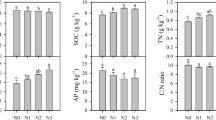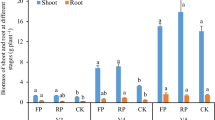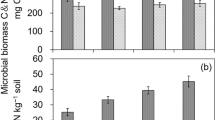Abstract
Background and aims
Soil autotrophic microorganisms and plant primary production play crucial roles in soil carbon (C) cycling. However, the information remains limited to whether and how nitrogen (N) application influences the contribution of soil microbial C fixation to the soil organic C (SOC) pool.
Methods
We investigated the effects of soil autotrophic bacterial communities on SOC storage and maize yield. A field experiment was conducted with four application rates of urea on the semiarid Loess Plateau, N application at 0 kg ha− 1 (N0), 100 kg ha− 1 (N1), 200 kg ha− 1 (N2), and 300 kg ha− 1 (N3), respectively.
Results
Our results showed that SOC storage and maize yield were significantly increased by N application, but no significant SOC storage difference between N2 and N3 treatments, no further yield increase beyond 200 N kg ha− 1 application was observed. N application significantly impacted soil Calvin-Benson-Bassham (CBB) (cbbL) gene-carrying bacterial communities via changing soil pH, nitrate N, and soil water content. The diversity of soil autotrophic bacterial communities decreased with increasing rate of N application. We detected a high abundance of the autotrophic bacterial dominant genera Xanthobacter, Bradyrhizobium, Aminobacter, and Nitrosospira. The co-occurrence network of autotrophic bacteria contained four distinct modules. Structural equation modeling further indicated that the autotrophic bacterial communities had positive relationships with SOC storage and maize yield.
Conclusions
Taken together, our results highlighted that N application stimulated the activity of soil autotrophic bacterial communities, contributing to an increase in SOC. The increase of SOC under N fertilization can stabilize soil fertility for maize production.






Similar content being viewed by others
References
Agegnehu G, Nelson PN, Bird MI (2016) Crop yield, plant nutrient uptake and soil physicochemical properties under organic soil amendments and nitrogen fertilization on Nitisols. Soil Tillage Res 160:1–13
Archer E (2016) rfPermute: Estimate permutation p-values for random forest importance metrics R package version 2.18
Bastian M, Heymann S, Jacomy M (2009) Gephi: An open source software for exploring and manipulating networks. Proceedings of the Third International Conference on Weblogs and Social Media, ICWSM 2009, San Jose, California, USA, May 17–20
Bento AP, Gaulton A, Hersey A, Bellis LJ, Chambers J, Davies M, Kruger FA, Light Y, Mak L, Mcglinchey S (2002) Classification and regression by randomforest. R News 23:18–22
Berg IA (2011) Ecological aspects of the distribution of different autotrophic CO2 fixation pathways. Appl Environ Microb 77:1925–1936
Berhane M, Xu M, Liang Z, Shi J, Wei G, Tian X (2020) Effects of long-term straw return on soil organic carbon storage and sequestration rate in North China upland crops: A meta‐analysis. Global Change Biol 26:2686–2701
Berry D, Widder S (2014) Deciphering microbial interactions and detecting keystone species with co-occurrence networks. Front Microbiol 5:219. https://doi.org/10.3389/fmicb.2014
Caporaso JG, Kuczynski J, Stombaugh J, Bittinger K, Bushman FD, Costello EK, Fierer N, Pena AG, Goodrich JK, Gordon JI (2010) QIIME allows analysis of high-throughput community sequencing data. Nat Methods 7:335. https://doi.org/10.1038/nmeth.f.303
Chen L, Jiang Y, Liang C, Luo Y, Xu Q, Han C, Zhao Q, Sun B (2019) Competitive interaction with keystone taxa induced negative priming under biochar amendments. Microbiome 7:1–18
Delgado-Baquerizo M, Maestre FT, Reich PB, Jeffries TC, Gaitan JJ, Encinar D, Berdugo M, Campbell CD, Singh BK (2016) Microbial diversity drives multifunctionality in terrestrial ecosystems. Nat Commun 7:1–8
Edgar RC (2013) UPARSE: highly accurate OTU sequences from microbial amplicon reads. Nat Methods 10:996. https://doi.org/10.1038/nmeth.2604
Esparza M, Cárdenas JP, Bowien B, Jedlicki E, Holmes DS (2010) Genes and pathways for CO2 fixation in the obligate, chemolithoautotrophic acidophile, Acidithiobacillus ferrooxidans, carbon fixation in A. ferrooxidans. BMC Microbiol 10:1–15
Faust K, Sathirapongsasuti JF, Izard J, Segata N, Gevers D, Raes J, Huttenhower C (2012) Microbial co-occurrence relationships in the human microbiome. PLoS Comput Biol 8:e1002606. https://doi.org/10.1371/journal.pcbi.1002606
Freilich S, Kreimer A, Meilijson I, Gophna U, Sharan R, Ruppin E (2010) The large-scale organization of the bacterial network of ecological co-occurrence interactions. Nucleic Acids Res 38:3857–3868
Ge T, Wu X, Liu Q, Zhu Z, Yuan H, Wang W, Whiteley AS, Wu J (2016) Effect of simulated tillage on microbial autotrophic CO2 fixation in paddy and upland soils. Sci Rep 6:19784. https://doi.org/10.1038/srep19784
Guo G, Kong W, Liu J, Zhao J, Du H, Zhang X, Xia P (2015) Diversity and distribution of autotrophic microbial community along environmental gradients in grassland soils on the Tibetan Plateau. Appl Microbiol Biot 99:8765–8776
Hooper D, Coughlan J, Mullen MR (2008) Structural equation modelling: guidelines for determining model fit. Elec J Buss Res Methods 6:141–146
Jiang Y, Li S, Li R, Zhang J, Liu Y, Lv L, Zhu H, Wu W, Li W (2017) Plant cultivars imprint the rhizosphere bacterial community composition and association networks. Soil Biol Biochem 109:145–155
Jiang Y, Liang Y, Li C, Wang F, Sui Y, Suvannang N, Zhou J, Sun B (2016) Crop rotations alter bacterial and fungal diversity in paddy soils across East Asia. Soil Biol Biochem 95:250–261
Jiang Y, Qian H, Wang X, Chen L, Liu M, Li H, Sun B (2018) Nematodes and microbial community affect the sizes and turnover rates of organic carbon pools in soil aggregates. Soil Biol Biochem 119:22–31
Jiao S, Peng Z, Qi J, Gao J, Wei G (2021) Linking bacterial-fungal relationships to microbial diversity and soil nutrient cycling. Msystems 6:e01052–e01020. https://doi.org/10.1128/mSystems.01052-20
Jones D, Willett V (2006) Experimental evaluation of methods to quantify dissolved organic nitrogen (DON) and dissolved organic carbon (DOC) in soil. Soil Biol Biochem 38:991–999
Kovaleva OL, Tourova TP, Muyzer G, Kolganova TV, Sorokin DY (2011) Diversity of RubisCO and ATP citrate lyase genes in soda lake sediments. FEMS Microbiol Ecol 75:37–47
Layeghifard M, Hwang DM, Guttman DS (2017) Disentangling interactions in the microbiome: a network perspective. Trends Microbiol 25:217–228
LeBauer DS, Treseder KK (2008) Nitrogen limitation of net primary productivity in terrestrial ecosystems is globally distributed. Ecology 89:371–379
Li Z, Tong D, Nie X, Xiao H, Jiao P, Jiang J, Li Q, Liao W (2021) New insight into soil carbon fixation rate: The intensive co-occurrence network of autotrophic bacteria increases the carbon fixation rate in depositional sites. Agr Ecosyst Environ 320:107579
Liao H, Qin F, Wang K, Zhang Y, Hao X, Chen W, Huang Q (2020) Long-term chemical fertilization-driving changes in soil autotrophic microbial community depresses soil CO2 fixation in a Mollisol. Sci Total Environ 748:141317. https://doi.org/10.1016/j.scitotenv.2020.141317
Liu M, Shen Y, Li Q, Xiao W, Song X (2021) Arbuscular mycorrhizal fungal colonization and soil pH induced by nitrogen and phosphorus additions affects leaf C: N: P stoichiometry in chinese fir (Cunninghamia lanceolata) forests. Plant Soil 461:421–440
Lu J, Qiu K, Li W, Wu Y, Ti J, Chen F, Wen X (2019) Tillage systems influence the abundance and composition of autotrophic CO2-fixing bacteria in wheat soils in North China. Eur J Soil Biol 93:103086. https://doi.org/10.1016/j.ejsobi.2019.103086
Maynard DS, Crowther TW, Bradford MA (2017) Competitive network determines the direction of the diversity–function relationship. Proc Natl Acad Sci USA 114:11464–11469
Miao Y, Stewart BA, Zhang F (2011) Long-term experiments for sustainable nutrient management in China. A review. Agron Sustain Dev 31:397–414
Muhammad Q, Huang J, Waqas A, Li D, Liu S, Zhang L, Cai A, Liu L, Xu Y, Gao J, Zhang H (2020) Yield sustainability, soil organic carbon sequestration and nutrients balance under long-term combined application of manure and inorganic fertilizers in acidic paddy soil. Soil Tillage Res 198:104569. https://doi.org/10.1016/j.still.2019.104569
Nelson D, Sommers LE (1983) Total carbon, organic carbon, and organic matter. In: Page AL, Miller RH, Keeney DR (eds) Eds.),Methods of soil analysis: Part 2 chemical and microbiological properties. American Society of Agronomy and Soil Science, Madison, pp 539–579
O’Kelly BC (2004) Accurate determination of moisture content of organic soils using the oven drying method. Dry Technol 22:1767–1776
Olsen SR (1954) Estimation of available phosphorus in soils by extraction with sodium bicarbonate. USDA Circular, 939
Qin J, Li M, Zhang H, Liu H, Zhao J, Yang D (2021) Nitrogen deposition reduces the diversity and abundance of cbbL gene-containing CO2-fixing microorganisms in the soil of the stipa baicalensis steppe. Front Microbiol 12:412. https://doi.org/10.3389/fmicb.2021.570908
Ramírez PB, Fuentes-Alburquenque S, Díez B, Vargas I, Bonilla CA (2020) Soil microbial community responses to labile organic carbon fractions in relation to soil type and land use along a climate gradient. Soil Biol Biochem 141:107692. https://doi.org/10.1016/j.soilbio.2019.107692
Rousk J, Bååth E, Brookes PC, Lauber CL, Lozupone C, Caporaso JG, Knight R, Fierer N (2010) Soil bacterial and fungal communities across a pH gradient in an arable soil. ISME J 4:1340–1351
Schloss PD, Westcott SL, Ryabin T, Hall JR, Hartmann M, Hollister EB, Lesniewski RA, Oakley BB, Parks DH, Robinson CJ (2009) Introducing mothur: open-source, platform-independent, community-supported software for describing and comparing microbial communities. Appl Environ Microbiol 75:7537–7541
Selesi D, Schmid M, Hartmann A (2005) Diversity of green-like and red-like ribulose-1, 5-bisphosphate carboxylase/oxygenase large-subunit genes (cbbL) in differently managed agricultural soils. Appl Environ Microbiol 71:175–184
Shen W, Lin X, Shi W, Min J, Gao N, Zhang H, Yin R, He X (2010) Higher rates of nitrogen fertilization decrease soil enzyme activities, microbial functional diversity and nitrification capacity in a Chinese polytunnel greenhouse vegetable land. Plant Soil 337:137–150
Sparks DL, Page A, Helmke P, Loeppert RH, Bremner JM (1996) Nitrogen-total. In: Sparks DL, Page AL (eds). Methods of soil analysis, part 3: Chemical methods. America Society of Agronomy, Inc., Madison, pp 1085–1121
Tolli JD, King GM (2005) Diversity and structure of bacterial chemolithotrophic communities in pine forest and agroecosystem soils. Appl Environ Microbiol 71:8411–8418
Vance ED, Brookes PC, Jenkinson DS (1987) An extraction method for measuring soil microbial biomass C. Soil Biol Biochem 19:703–707
Wang C, Liu D, Bai E (2018) Decreasing soil microbial diversity is associated with decreasing microbial biomass under nitrogen addition. Soil Biol Biochem 120:126–133
Wang J, Xie J, Li L, Luo Z, Zhang R, Wang L, Jiang Y (2021) The impact of fertilizer amendments on soil autotrophic bacteria and carbon emissions in maize field on the semiarid Loess Plateau. Front Microbiol 12:1414
Wang X, Bian Q, Jiang Y, Zhu L, Chen Y, Liang Y, Sun B (2021) Organic amendments drive shifts in microbial community structure and keystone taxa which increase C mineralization across aggregate size classes. Soil Biol Biochem 153:108062. https://doi.org/10.1016/j.soilbio.2020.108062
Wang X, Fan J, Xing Y, Xu G, Wang H, Deng J, Wang Y, Zhang F, Li P, Li Z (2019) The effects of mulch and nitrogen fertilizer on the soil environment of crop plants. Adv Agron 153:121–173
Wang Y, Huang Q, Liu C, Ding Y, Liu L, Tian Y, Wu X, Li H, Awasthi MK, Zhao Z (2020) Mulching practices alter soil microbial functional diversity and benefit to soil quality in orchards on the Loess Plateau. J Environ Manage 271:110985. https://doi.org/10.1016/j.jenvman.2020.110985
Wiegel J (2006) The genus Xanthobacter. Prokaryotes 5:290–314
Wiesmeier M, Urbanski L, Hobley E, Lang B, von Lützow M, Marin-Spiotta E, van Wesemael B, Rabot E, Ließ M, Garcia-Franco N (2019) Soil organic carbon storage as a key function of soils-A review of drivers and indicators at various scales. Geoderma 333:149–162
Wu X, Ge T, Wang W, Yuan H, Wegner CE, Zhu Z, Whiteley AS, Wu J (2015) Cropping systems modulate the rate and magnitude of soil microbial autotrophic CO2 fixation in soil. Front Microbiol 6:379. https://doi.org/10.3389/fmicb.2015.00379
Wu X, Ge T, Yuan H, Zhou P, Chen X, Chen S, Brookes P, Wu J (2014) Evaluation of an optimal extraction method for measuring d-ribulose-1, 5-bisphosphate carboxylase/oxygenase (RubisCO) in agricultural soils and its association with soil microbial CO2 assimilation. Pedobiologia 57:277–284
Xiao D, Huang Y, Feng S, Ge Y, Zhang W, He X, Wang K (2018) Soil organic carbon mineralization with fresh organic substrate and inorganic carbon additions in a red soil is controlled by fungal diversity along a pH gradient. Geoderma 321:79–89
Xiao H, Li Z, Chang X, Deng L, Nie X, Liu C, Liu L, Jiang J, Chen J, Wang D (2018) Microbial CO2 assimilation is not limited by the decrease in autotrophic bacterial abundance and diversity in eroded watershed. Biol Fert Soils 54:595–605
Xiao H, Li Z, Deng C, Liu L, Chen J, Huang B, Nie X, Liu C, Wang D, Jiang J (2019) Autotrophic bacterial community and microbial CO2 fixation respond to vegetation restoration of eroded agricultural land. Ecosystems 22:1754–1766
Xie J, Wang L, Li L, Coulter JA, Chai Q, Zhang R, Luo Z, Carberry P, Rao K (2020) Subsoiling increases grain yield, water use efficiency, and economic return of maize under a fully mulched ridge-furrow system in a semiarid environment in China. Soil Tillage Res 199:104584. https://doi.org/10.1016/j.still.2020.104584
Yuan G, Huan W, Song H, Lu D, Chen X, Wang H, Zhou J (2021a) Effects of straw incorporation and potassium fertilizer on crop yields, soil organic carbon, and active carbon in the rice–wheat system. Soil Tillage Res 209:104958. https://doi.org/10.1016/j.still.2021.104958
Yuan Q, Wang P, Wang C, Chen J, Wang X, Liu S (2021b) Indicator species and co-occurrence pattern of sediment bacterial community in relation to alkaline copper mine drainage contamination. Ecol Indic 120:106884. https://doi.org/10.1016/j.ecolind.2020.106884
Yuan H, Ge T, Chen C, O’Donnell AG, Wu J (2012a) Significant role for microbial autotrophy in the sequestration of soil carbon. Appl Environ Microb 78:2328–2336
Yuan H, Ge T, Wu X, Liu S, Tong C, Qin H, Wu M, Wei W, Wu J (2012b) Long-term field fertilization alters the diversity of autotrophic bacteria based on the ribulose-1,5-biphosphate carboxylase/oxygenase (RubisCO) large-subunit genes in paddy soil. Appl Microbiol Biot 95:1061–1071
Zang H, Blagodatskaya E, Wang J, Xu X, Kuzyakov Y (2017) Nitrogen fertilization increases rhizodeposit incorporation into microbial biomass and reduces soil organic matter losses. Biol Fert Soils 53:419–429
Zhang X, Davidson EA, Mauzerall DL, Searchinger TD, Dumas P, Shen Y (2015) Managing nitrogen for sustainable development. Nature 528:51–59
Zheng T, Xie H, Thompson GL, Bao X, Deng F, Yan E, Zhou X, Liang C (2021) Shifts in microbial metabolic pathway for soil carbon accumulation along subtropical forest succession. Soil Biol Biochem :108335. https://doi.org/10.1016/j.soilbio.2021.108335
Zhou Z, Wei W, Shi X, Liu Y, He X, Wang M (2019) Twenty-six years of chemical fertilization decreased soil RubisCO activity and changed the ecological characteristics of soil cbbL-carrying bacteria in an entisol. Appl Soil Ecol 141:1–9
Acknowledgements
This work was supported by the Education science and technology innovation project of Gansu Province (GSSYLXM − 02), the Fostering Foundation for the Excellent Ph.D. Dissertation of Gansu Agricultural University (YB2020002), the National Natural Science Foundation of China (31761143004, 41922048), the Innovation Star Project for Excellent Graduate Student of Gansu Province Educational Department (2021CXZX-369), the Department of Science and Technology of Gansu Province (GSPT − 2018 − 56), and the Young Instructor Fund Project of Gansu Agricultural University (GAU-QDFC-2020-03).
Author information
Authors and Affiliations
Contributions
Ling Li and Yuji Jiang conceived the topic. Jinbin Wang, Junhong Xie, Zhuzhu Luo, and Renzhi Zhang performed the experiments. Jinbin Wang analyzed all statistical data. Jinbin Wang and Yuji Jiang wrote the manuscript. All authors have read and approved the manuscript.
Corresponding authors
Ethics declarations
Conflict of interest
The authors declare no conflicts of interest.
Additional information
Responsible Editor: Florian Wichern.
Publisher’s note
Springer Nature remains neutral with regard to jurisdictional claims in published maps and institutional affiliations.
Supplementary Information
Below is the link to the electronic supplementary material.
ESM 1
(DOCX 180 KB)
Rights and permissions
About this article
Cite this article
Wang, J., Xie, J., Li, L. et al. Nitrogen application increases soil microbial carbon fixation and maize productivity on the semiarid Loess Plateau. Plant Soil 488, 9–22 (2023). https://doi.org/10.1007/s11104-022-05457-7
Received:
Accepted:
Published:
Issue Date:
DOI: https://doi.org/10.1007/s11104-022-05457-7




